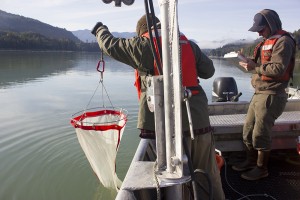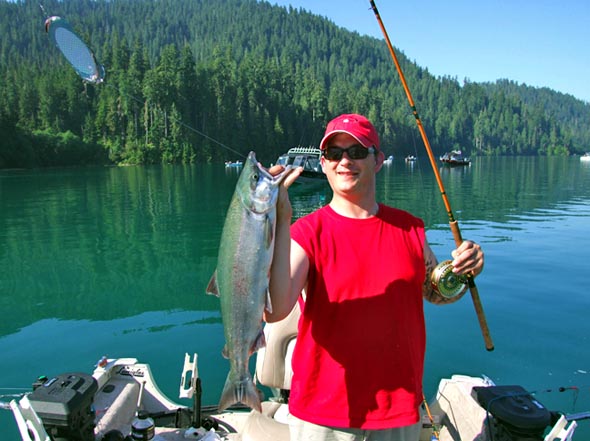By Wayne Kruse, The Herald
Never been interested in getting involved in the annual salmon season-setting process? Maybe you should rethink that position, and here’s a specific example of how public input can affect your fishing opportunity:
The preseason forecast for the uber-popular Baker Lake sockeye fishery is 35,380 fish, according to Washington Department of Fish and Wildlife biologist Brett Barkdull in La Conner. That’s not as good as the numbers for the initial fishery in 2012, when the run clocked in at about 48,000, but much better than last summer’s meager 18,000 fish.
So there should be plenty of sockeye for a pretty good season this year. But the guy in the back of the room raises his hand and asks, “Who gets to catch ’em?”
Will it be primarily the bank fisherman on the lower Skagit, plunking with Spin N Glo and shrimp? Or will it the boater on Baker Lake, with downriggers and trolling gear? Or should the catch be split between the two very distinct user groups? That’s the question you can help answer by being at the public meeting 6-9 p.m., March 22nd at WDFW’s Mill Creek office (16018 Mill Creek Boulevard, phone 425-775-1311).
“The public will decide,” Barkdull said. “It’s their fish, and we’re taking input right now.”
The recreational sockeye catch on the river during the 2012 season was 4,300 fish, despite terrible fishing conditions. “The river was high, cold, dirty and people were dodging trees,” Barkdull said. The catch in the lake that summer was 9,600 salmon.
The river opened June 16 and the lake on July 1 in 2012. There were not enough fish predicted last year for both a river and lake fishery, so the lake opened July 10. This year?
“Nothing’s set,” Barkdull said. “It’s a relatively new fishery, and the where and how are still shaking out.”
He said last year’s preseason discussions were influenced more heavily by a larger contingent of lake-oriented anglers. Many of the river fishermen, by contrast, were apparently afraid that if they once lost the river option, they would never get it back.
“That’s not true,” Barkdull said. “One of our management goals is to harvest more than the roughly 50 percent of hatchery sockeye caught in the first two seasons, and both a river and a lake fishery might be one way to do that.”
If a river opening becomes part of the sockeye scenario, it will not be at the mouth of the Baker River. Barkdull said that small area drew crowds and some confrontations in the past, so the fishery was moved downstream. The hot spots during the 2012 river fishery, Barkdull said, were Young’s Bar, just upriver from downtown Mount Vernon; the “soccer fields,” farther upriver; and at Gilligan Creek, above Sedro-Woolley.
Only about 6,000 sockeye were trucked last year from the power company fish trap to the lake, resulting in a slow — and short — season. If, say, 15,000 fish could be trapped and trucked this year, that would likely result in a very good fishery.
Derby
Next up in the Northwest salmon derby Series is the 8th running of the Everett Blackmouth Derby, March 22, marine areas 8-1, 8-2 and 9, offering a first place cash prize of $3,000. Tickets are limited to 100 boats, at $100 per boat (up to four anglers), and available at John’s Sporting Goods, Bayside Marine, Greg’s Custom Rods, Ted’s Sport Center, Ed’s Surplus, Three Rivers Marine, Performance Marine, and Harbor Marine.
For more information go to www.everettblackmouthderby.com.
Learn how
Tackle shop owner John Martinis and expert angler Mike Greenleaf will host an hour-long chinook fishing seminar at 7 p.m. March 19 at Bayside Marine, 1111 Craftsman Way, Everett. The free seminar will cover where to fish, rigging gear, rigging bait, selecting tackle and more. Martinis’ phone number is 425-259-3056; Bayside Marine’s number is 425-252-3088.
Local blackmouth
All Star Charters owner/skipper Gary Krein said the fairly good fishing for blackmouth on outer Possession Bar has held up well, but that near-flood-level rivers have pumped mud, logs and other debris into the area, making getting from Everett to the outer bar a risky endeavor.
“And we had to go at least halfway across the bar to find clean water early this week,” Krein said.
Columbia River
Still no springers showing in the popular fishing areas of the lower Columbia, according to Joe Hymer, state biologist in Vancouver.
“Despite sampling 100 boats and just over 100 bank fishermen, we checked one steelhead last week,” Hymer said on Monday. “In fact, we still haven’t sampled our first spring chinook of the season.”
Farther upriver, walleye fishermen were doing much better. State checks on The Dalles Pool last week showed 35 boat fishermen had kept 38 walleye and released 21 more. On the John Day Arm and vicinity, 39 fishermen kept 22 and released nine fish.
And above the Tri-Cities, the Ringold-area steelhead fishery has finally come on. State personnel last week checked 14 bank and 12 boat fishermen, with 18 hatchery steelhead. Anglers averaged between six and 16 hours per fish.
Smelt
Recreational smelt dipping in the Cowlitz on Saturday was excellent, state biologist Joe Hymer said. Most dippers were harvesting their 10-pound limit in only a few dips.
Smelt were reported as far upstream on the Cowlitz as Blue Creek, and also reported in the North Fork Lewis and as far up the mainstem Columbia as Vancouver.
No more recreational smelt fisheries were scheduled, as of early this week, Hymer said.
Record walleye
A record Washington State walleye was caught Feb. 28 on Lake Wallula (McNary Pool, Columbia River) by John Grubenhoff of Pasco. The fish weighed 20.32 pounds, was 35.5 inches long, and had a girth of 22.75 inches. Grubenhoff was trolling upstream along a current break in 22 feet of water, using a Rapala J-13, six feet behind a 2-ounce bottom walker.
The previous record walleye was also caught in February, 2007, in the same Columbia pool, by Mike Hepper of Richland, and weighed 19.3 pounds.
Wolves stable
The Washington Department of Fish and Wildlife released over the weekend its official annual count of gray wolves living in the state: 52 individuals; one more than found in the 2012 count, and the same number of breeding pairs as reported in 2012. Wolves in eastern Washington were federally delisted a few years ago, but they are still protected under state endangered species laws.
Free seminars
Cabela’s Tulalip store presents Spring Great Outdoor Days this weekend, March 15-16, offering free seminars, turkey calling contests, Dutch oven cooking, bow fishing and more.
Highlights include: Introduction to Reloading; Dutch Oven Meals; Turkey Calling Techniques and Fine Tuning Your Hunting Skills; Applying for Out of State Tags; and Spring Bear Hunting and Calling Tips & Tactics.




